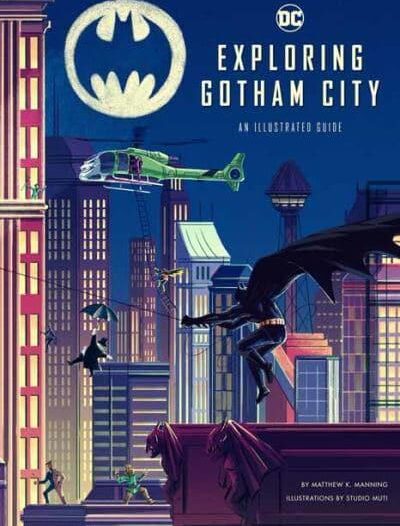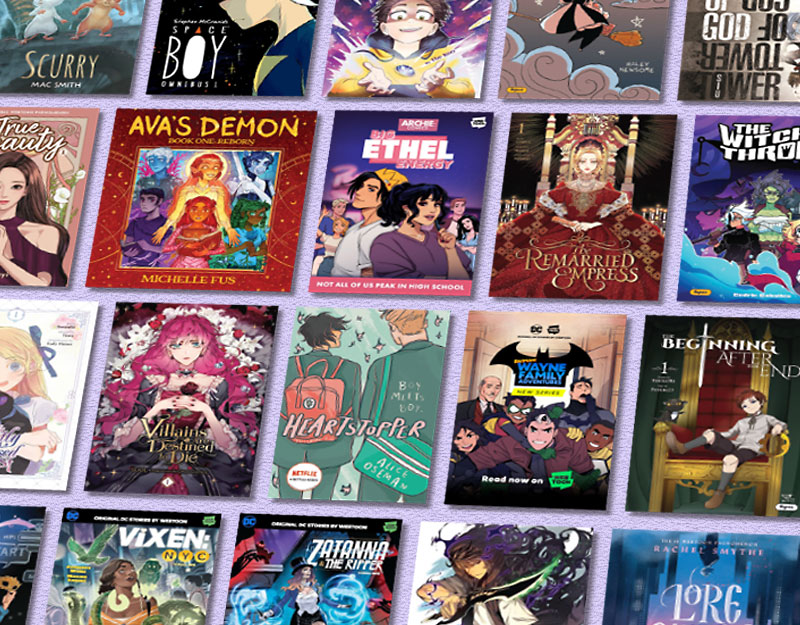
Exploring Gotham City | Interview
 It’s never been too difficult to visit Gotham City; all one needed to do was open a Batman comic book and there you were. But the new guidebook Exploring Gotham City (Insight Kids, March 2021, ages 8-12) allows readers to visit in a whole new—and much more immersive—way.
It’s never been too difficult to visit Gotham City; all one needed to do was open a Batman comic book and there you were. But the new guidebook Exploring Gotham City (Insight Kids, March 2021, ages 8-12) allows readers to visit in a whole new—and much more immersive—way.
The work of writer Matthew K. Manning and the artists of Studio MUTI, the book’s focus is on the city itself, with the setting as springboard to a discussion of the characters and the now eight-decade long saga of Batman.
ADVERTISEMENT
ADVERTISEMENT
Each of the book’s 17 locations is covered in a huge, 14-inch-by-19-inch spread—or, in the case of the Batcave, four such spreads—which details the features of the building or neighborhood, while also overflowing with references to past storylines and little profiles of Batman’s enemies and allies, all of whom appear at various points throughout the book as tiny little sprites, as the scale of the book is that of buildings, not people.
Because of its focus on the setting, Exploring Gotham City tells, in one sense, all Batman stories, and it does so in a single, hyper-condensed volume that manages to make the character’s long and colorful fictional career all seem like a single, consistent narrative. It similarly sets the stage for all future stories—both those DC Comics writers and artists will come up with, and those the readers will imagine for themselves—as it’s a rare Batman story that doesn’t take place at least in part in Gotham City.
From noteworthy buildings like Arkham Asylum, The Iceberg Lounge and Ace Chemical to neighborhoods like The East End, The Narrows, and Burnside, Manning and MUTI seem to have mapped out and explored the comic book city from sewer to spire. I spoke with Manning about some of the work that went into creating such an unusual Batman book.
Did you choose the particular locations within Gotham City to explore in the book, or were they arrived at BY working with editors or with people from DC? Can you give us some insight into how particular locations were chosen, given you had some 80+ years of Batman comics to choose inspiration from?
Manning: I chose the locations for the book. I tried to pick places that were featured prominently in some of the more major storylines, along with spots Batman visits on a daily basis.
As a fantasy setting, Gotham City seems at first blush like the sort of place a writer can make up as they go along, and certainly that was the case in the earlier decades of the comics and new, mass media adaptations. But as I was reading, it became somewhat remarkable how much of the city is actually already set in stone, as it were, by so many stories. Did you encounter a tension between the wide open space offered by a fictitious city and the parameters imposed by so many past comics stories?
Gotham City really became a cohesive city during Denny O’Neil’s tenure as editor of the Bat-books. He hired Anton Furst to design a comic book counterpart to the Gotham Anton envisioned as production designer for the ’89 Batman film.
And honestly, that’s one of the reasons I fell in love with Batman’s world in the first place. To me, it’s not an imposition that the city has so many landmarks and famous locations, it’s a plus. It makes a more realized playground for Batman and his cast to explore.
Can you tell us a little bit about the research process of the book? I’ve been reading Batman comics off and on since the late 1980s or so, and it sure seems like you managed to cover, well, everything. Did you sit down and read, like, 83 years of Batman comics before you started, or did you find yourself revisiting particular eras? I assume from your other work that you already had plenty of Batman trivia tucked away in your brain before writing the first word of this book.
I’ve been reading everything Batman that I can get my hands on ever since I was ten and the 1989 movie hit theaters. At this point in my career, I’ve read most everything there is to read, and what I haven’t read, I’ve at least skimmed through.
I’ve written the month-by-month history book Batman: A Visual History, co-wrote The Batman Vault (which explored the story behind the comics), and told Batman’s history from his own point of view in The Batman Files. I’ve also written the Batman Character Encyclopedia and just finished up an update to DK’s Batman Ultimate Guide, so this sort of thing doesn’t require as much research as it does jogging my memory.
Did the various reboots and restarts of the comics cause any hiccups or present any stumbling blocks for you as you went, in terms of deciding which stories to count? What about various media adaptations: Did those impose temptations in terms of what version of, say, Wayne Manor or Arkham Asylum to include?
There were a few contradictions that I attempted to smooth out in this book. Including both the Wayne Foundation and the R.H. Kane Building was one, as the latter is pretty much a modern reinvention of the former. But they’re both too much fun, and there’s no reason Gotham City can’t have two buildings with trees growing through them! There were a few other minor contradictions, but nothing that posed too big of a problem.
As far as media interpretations, I kept to the comics for this one, and supplied reference for the most up-to-date versions of the buildings we cover.
Can you walk us through the writing process on a typical page? Beyond pointing out items of interest about the featured location, each page refers to multiple past storylines, introductions and outlines of particular characters, and so on. How did you go about deciding what to include, how much to include, and where to include it?
For this project, I started by pulling reference for each location, which led to me diving into a good number of comics from my collection. (I’ve collected over 15,000 Batman-related comics over the years, so that took some time!)
There’s so much material, it was more about hitting all the high notes and trying to be as thorough as possible when it comes to explaining each location and its various details and features.
After the text was written, my editor suggested including some Easter eggs to liven up the spreads, and I decided to give most of the pages little storylines, whether that be watching Catwoman sneak into the various rooms of Wayne Manor or seeing the League of Assassins slowly invade the Batcave.
ADVERTISEMENT
ADVERTISEMENT
Would you say Gotham City presents a uniquely rich subject for a book like this, or could you imagine writing similar books on, say, Superman’s Metropolis or Marvel Comics’ version of New York City…?
Gotham probably has the best atmosphere, but I would love to tackle either (or both) of those ideas you mentioned. DC does have the advantage over Marvel in that its fictional landscape is unique and not as constrained to real world locations. A map of Metropolis is inherently more interesting than a map of New York City, but despite representing “the world outside your window,” Stan Lee and company managed to include plenty of locations that aren’t on any normal map. Entries on the Baxter Building and Daily Bugle would be just as fun as spreads about The Daily Planet and LexCorp.
Were there any locations in Gotham City that might have made fun entries, but there just wasn’t room to include? Or locations that might have fit in as the setting of Batman stories, but just didn’t work with the Gotham City theme of the book…?
There are plenty of other locations I would’ve liked to have room for, from the Gotham Aquarium to the Statue of Justice (Gotham’s Statue of Liberty), to Joker’s Ha-Hacienda. And I would have loved to delve into the Justice League Watchtower, Nightwing’s city of Blüdhaven or even Titans Tower, but we’d be leaving Gotham in order to cover those. Here’s hoping we can do another volume in the future to get to some of the places we missed!
Filed under: Interviews
About J. Caleb Mozzocco
J. Caleb Mozzocco is a way-too-busy freelance writer who has written about comics for online and print venues for a rather long time now. He currently contributes to Comic Book Resources' Robot 6 blog and ComicsAlliance, and maintains his own daily-ish blog at EveryDayIsLikeWednesday.blogspot.com. He lives in northeast Ohio, where he works as a circulation clerk at a public library by day.
ADVERTISEMENT
ADVERTISEMENT
SLJ Blog Network
Name That LEGO Book Cover! (#53)
Cover Reveal and Q&A: The One and Only Googoosh with Azadeh Westergaard
Fighting Public School Book Bans with the Civil Rights Act
ADVERTISEMENT







